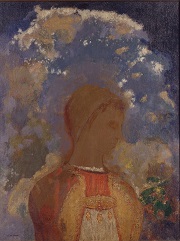Collection GallerySpecial Feature
Discovery of "Painting" - Development of Modern French Art
Special Feature
Discovery of "Painting" - Development of Modern French Art
HOME > Exhibitions > The 4th Collection Gallery Exhibition 2014-2015 > Special Feature Discovery of "Painting" - Development of Modern French Art

Bouddha dans sa jeunesse, 1905
Due to the social change caused by social revolutions and the industrial revolution, the environment surrounding art, especially paintings, went through significant change. Until then, paintings with historical or mythological themes and portraits of people of high social standing were considered most important and authoritative. Such paintings were completed inside the artists' ateliers based on meticulous sketches executed either indoors or outdoors.
However, as demand for paintings spread from the upper classes such as aristocrats and clergymen to the middle class, there was a growing tendency to choose more familiar themes such as nature and the daily activities of the people, and depict them as they were. The most characteristic style of all is the Realism movement, represented by Gustave Courbet.
"Depicting what the artist sees" necessitated opening the doors of the artist's atelier, which used to serve as an indoor venue for finishing outdoor work. The pioneer for this movement was the French painter, Eugène-Louis Boudin, who instilled in Claude Monet the importance of painting outdoors (en plein air).
Painting what the artist sees was related to emphasizing "what the artist sees and how it looks" more than the theme of the artwork. This tendency to emphasize vision was exemplified in the work of the Impressionist painters such as Claude Monet and Pierre-Auguste Renoir who tried to capture the transition of light on canvas, and the Neo-impressionist artists such as Paul Signac and Georges Seurat who analyzed "light" technically and developed pointillism. Painting what the artist sees was also related to the awareness of "that which is invisible." The artists who tried to depict the invisible world both symbolically and allegorically were the "Symbolists (symbolistes)" such as Odilon Redon.
Such drastic changes in paintings provided artists with an opportunity to reconsider the existence and significance of "painting" as a whole. Maurice Denis, who established the avant-garde art group "Les Nabis," together with Pierre Bonnard and Édouard Vuillard, left the following famous words which summarize the change of pictorial expressions from the mid-19th century; "A painting, before being a nude, a battle horse, an anecdote and whatnot, is essentially a flat surface covered with colors assembled in a certain order." Denis' idea became deeply rooted in the awareness of pictorial expressions in the 20th century, which was passed on to such movements as Cubism represented by Pablo Piccaso who tried to express 3-dimensional objects in the 2-dimension plane by utilizing plural perspectives, and Fauvism represented by Henri Matisse who tried to utilize colors according to his inner feelings, rather than in relation to the theme of the painting.
Although such phenomena, which could be interpreted as a "Discovery of 'painting'," can be found all over Europe in the latter half of the 19th century, the center of the movement was located in Paris, France. The overwhelmingly artistic vitality of Paris attracted many talented painters with a variety of cultural backgrounds, drawing them to the city from all over the world. This in turn contributed to further artistic development in Paris. Our special feature presents a portion of this rich development of modern French paintings, ranging from Jean-Baptiste Camille Corot, who exerted a great influence on the Impressionist painters by poetically depicting townscapes and the people in Paris in the mid-19th century, foreign painters who gathered in Paris during the two world wars in the 20th century, to painters of the École de Paris, such as Amedeo Clemente Modigliani and Marc Chagall.
Top of this page


